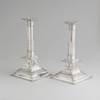I’m using a small subset of the very large Metropolitan Museum of Art collection. Specifically, I’ll be looking at every image tagged “candlestick.” (Here’s the search results from their website; at the time of this writing it returns 935 results, of which 801 records have images.)
Sample of the first handful of results:











Note that there are a few computational trickynesses already present at first blush:
- Some images are near-duplicates of others; this appears to generally be because the museum has two items from the same edition, acquired at different times
- background color/gradient and photo composition aren’t uniform
- some images contain more than one candlestick
I’d like to extract the contours of the sides of all of the candlesticks and use these as the basis for a comparison of different shapes, as well as possibly assembling one megacandlestick by virtually stacking these all on top of each other, end to end.